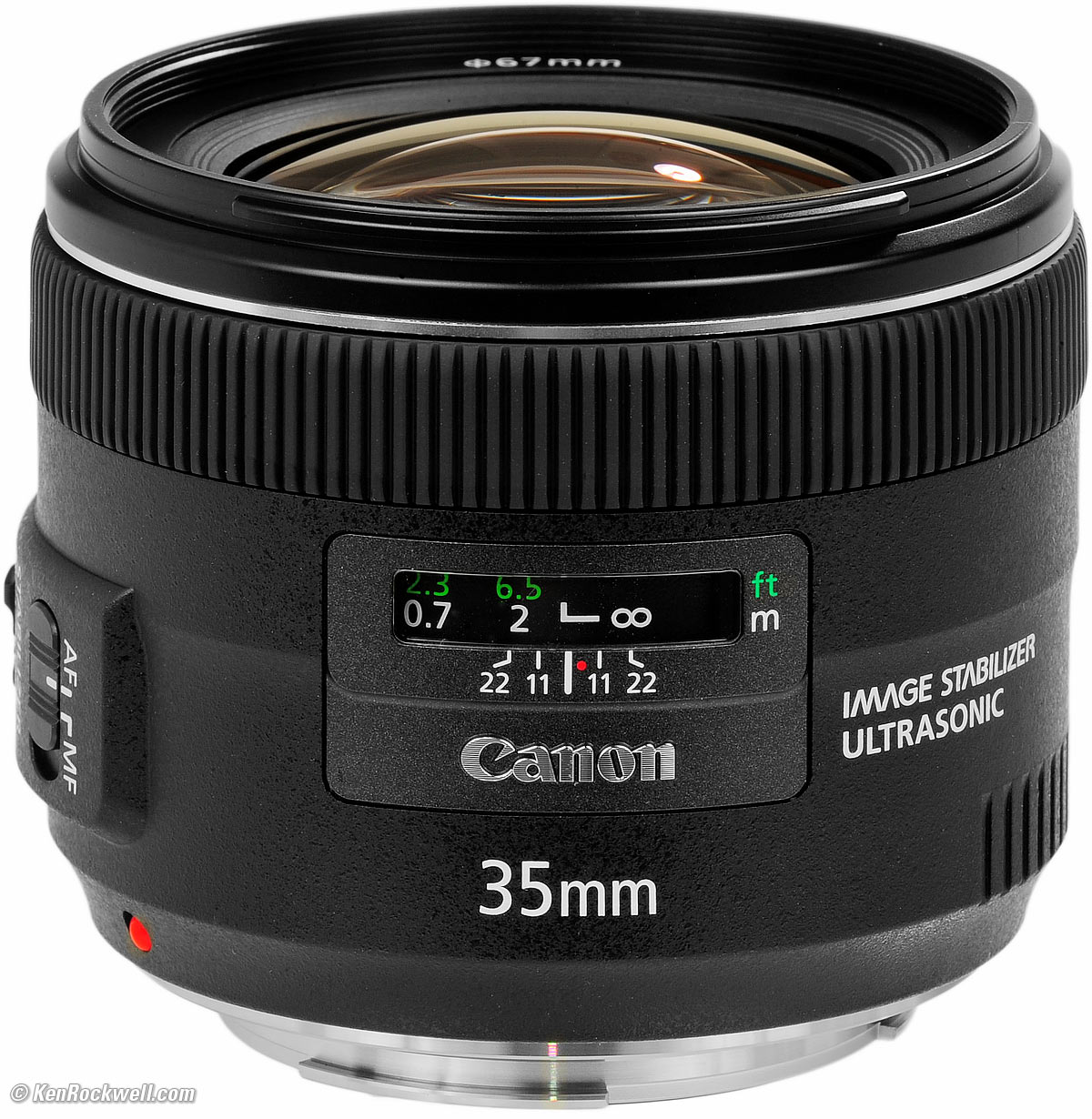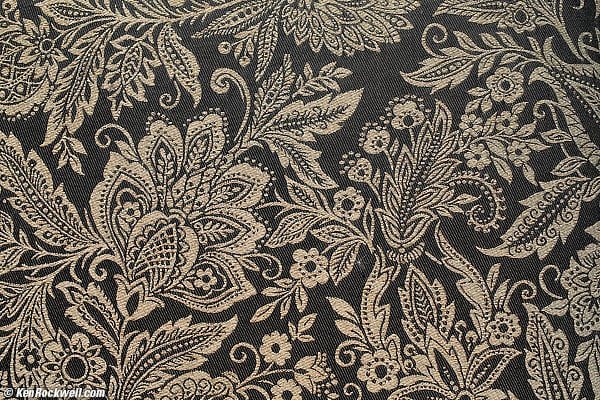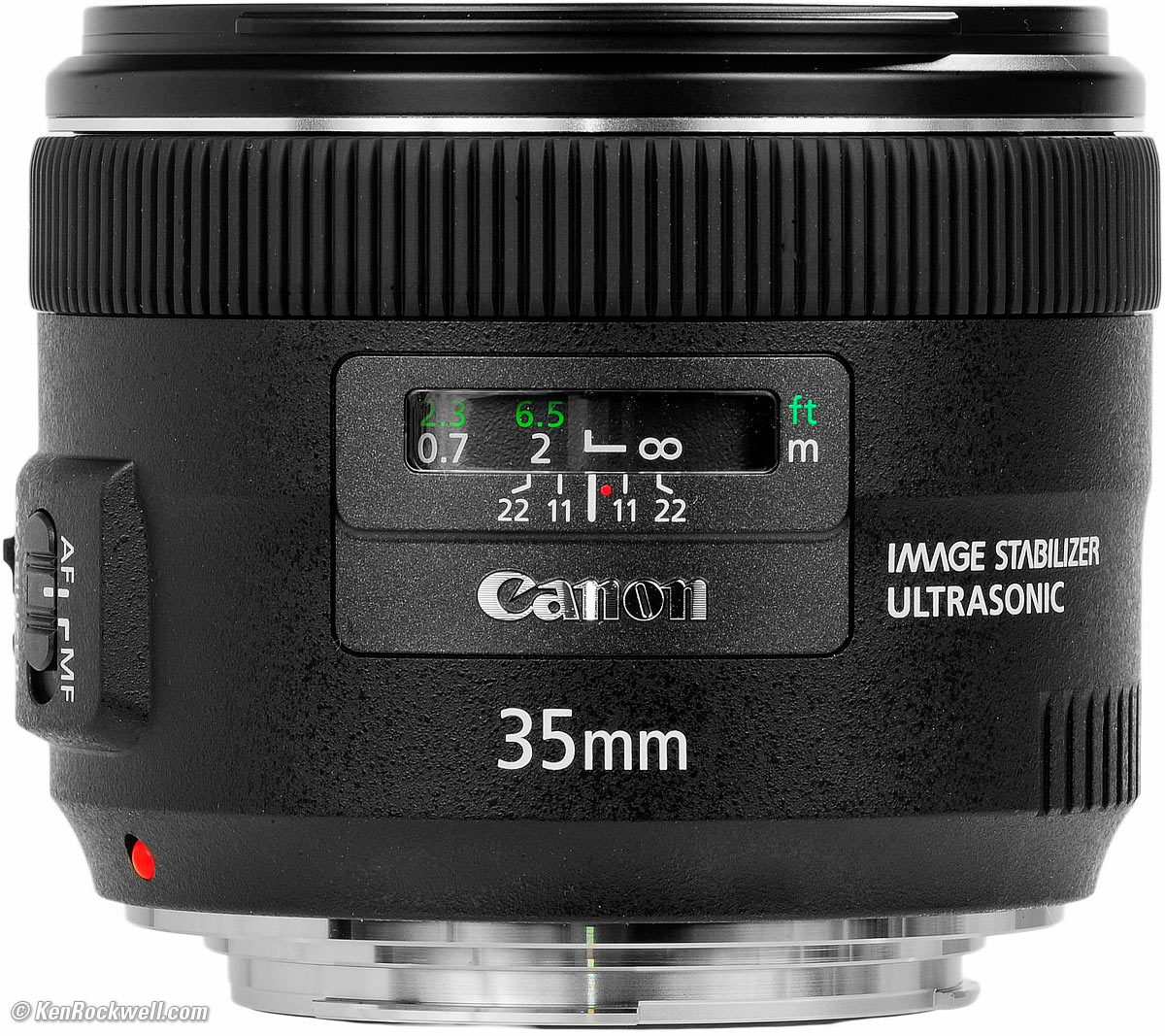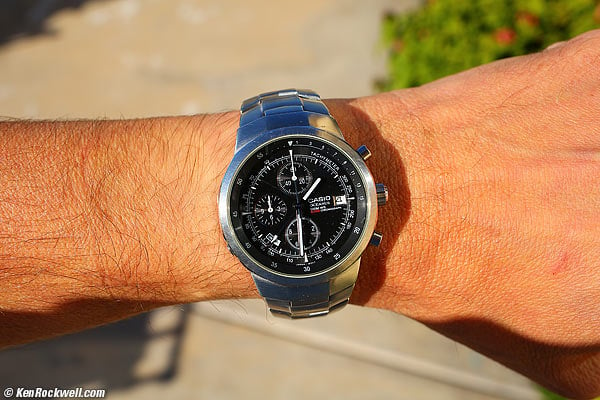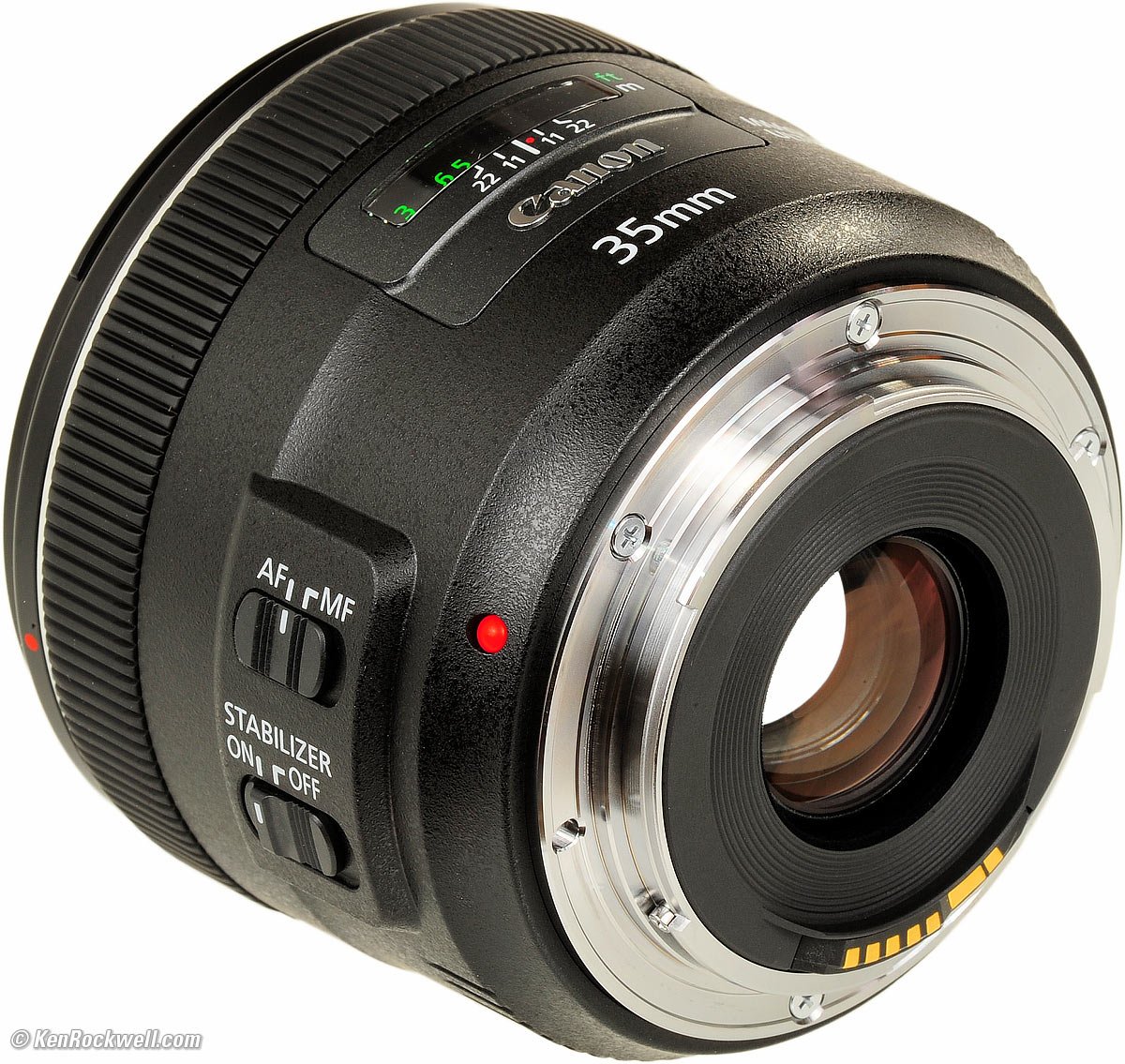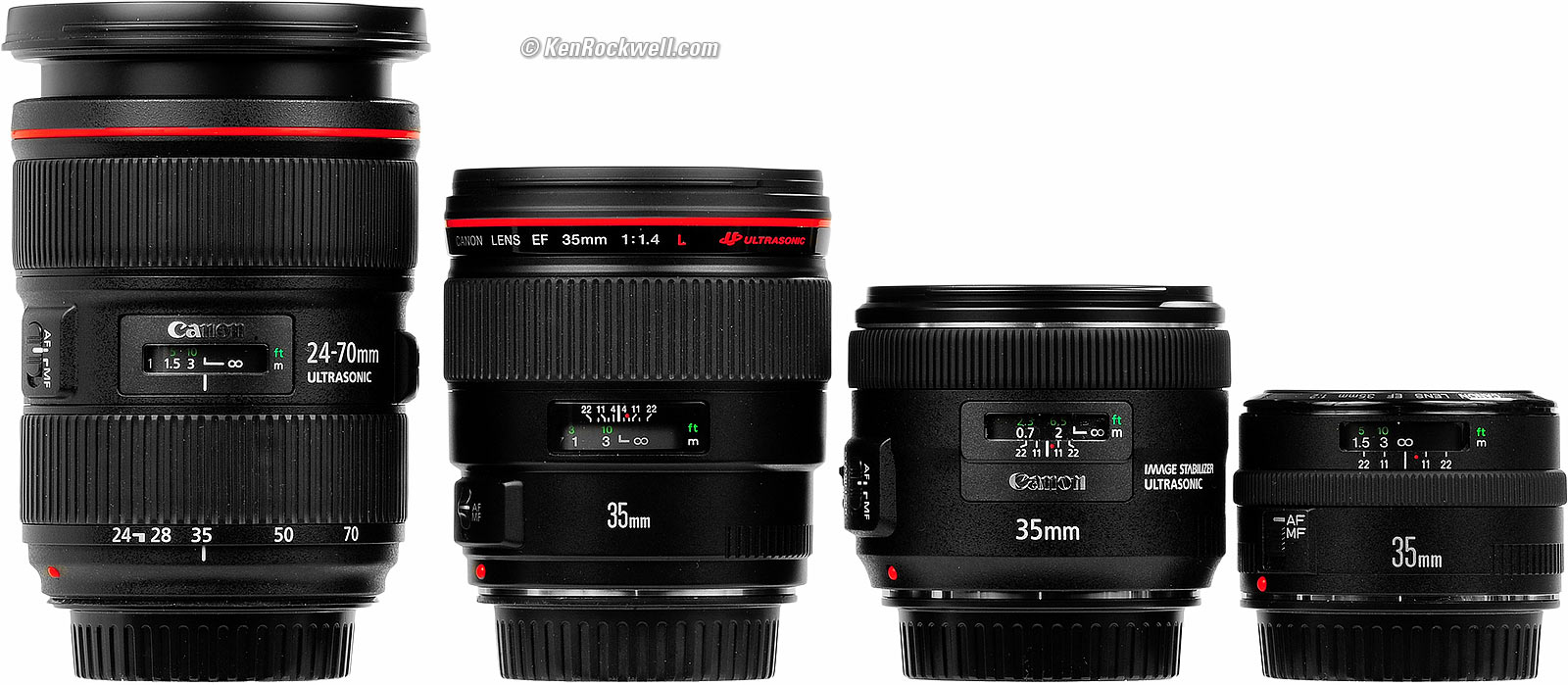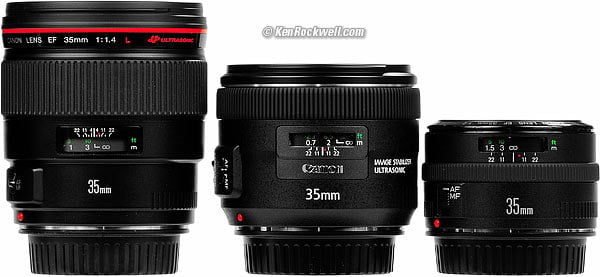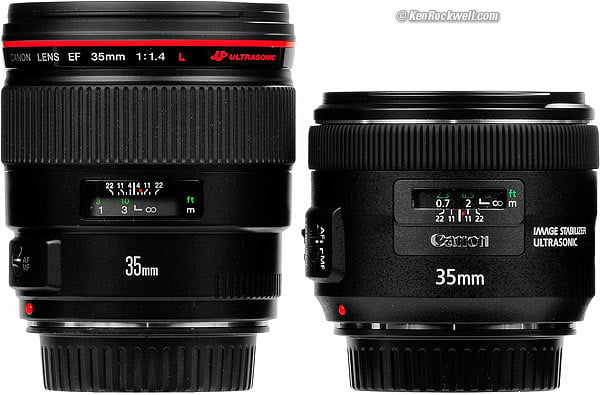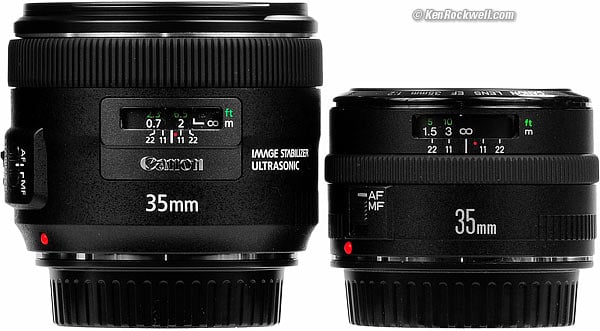Home Donate New Search Gallery Reviews How-To Books Links Workshops About Contact
Canon 35mm f/2 IS
Full-Frame EF USM (2012-today)
Intro Specs Performance Compared Recommendations
Canon EF 35mm f/2 IS USM (67mm filter thread, 0.8 feet/0.24m close-focus, 11.9 oz./336g, about $550.) enlarge. This free website's biggest source of support is when you use these links, especially this link directly to it at Adorama and to it at Amazon, when you get anything, regardless of the country in which you live. Thanks! Ken.
January 2017 More Canon Reviews Canon Lenses All Reviews
35mm f/1.4 L (1998-)
35mm f/2 (1990-)
Sample Image File
Fabric, close-up at f/8 at ISO 100, Canon 5D Mk III. Full-resolution © 22MP image.
Introduction top
Intro Specs Performance Compared Recommendations
This Canon 35mm f/2 IS USM is an all-new high-speed, wide-angle lens.
Compared to the previous model Canon 35mm f/2 (1990-), this new IS lens adds image stabilization and instant manual-focus override: just grab the focus ring at any time.
This new lens is 63% heavier than the previous lens, and costs almost three times as much. Optical quality is about the same: both are excellent.
Optics and IS work extremely well, but is it worth triple the price of the earlier 35mm f/2? The fully professional 35mm f/1.4 L (1998-) sells for not much more than this mostly plastic consumer IS lens. Hopefully my review will let you determine if it's worth it — to you.
This new 35 IS is a great lens, but I don't know if it's worth $550 when the previous model is so superb for much less money. No Canon 35mm f/2 is an L lens; the only 35mm L lens is the 35mm f/1.4 L (1998-), which is the only Canon 35mm lens built pro-tough.
Compatibility
This 35/2 IS lens is optimized for 35mm film and full-frame digital, and of course works on 1.3x and 1.6x Canon cameras.
This Canon EF EOS 35mm f/2 IS works perfectly with every Canon EOS camera ever made, meaning every Canon DSLR and every Canon autofocus film camera made since 1987.
This means of course it works great on today's 5D Mark III, 6D and Canon 7D, but it works just as well on my original Canon EOS 650 from 1987!
Canon 35mm f/2 IS. enlarge.
Specifications top
Intro Specs Performance Compared Recommendations
Name
Canon calls this the CANON LENS EF 35mm f/2 IS USM.
EF means "electronic focus," meaning that there is an autofocus motor in the lens itself. All Canon lenses since 1987 have been EF.
IS means Image Stabilization.
Ultrasonic or USM means Ultra-Sonic Motor. This means autofocus is almost silent, and that you can grab the big focus ring for instant manual focus override at any time.
Optics top
10 elements in 8 groups.
One molded glass aspherical element.
Rear focus: nothing moves externally as autofocused.
Multicoated, branded as "Optimized Super Spectra Coating."
Focal Length top
35mm.
On 1.3x Canon cameras it will see angles-of-view similar to what a 45mm lens would see on a 35mm camera.
On 1.6x Canon cameras it will see angles-of-view similar to what a 55mm lens would see on a 35mm camera, which is actually a very useful zoom range.
Angle of View (on 35mm and full-frame cameras)
63º diagonal.
38º vertical.
54º horizontal.
Close Focus top
0.8 feet (0.24m), specified, from the image plane.
Maximum Reproduction Ratio top
1:4.17 (0.24x), specified.
With EF12 II tube: 1:1.67 (0.60x).
With EF25 II tube: 1:0.96 (1.04x, larger than life-sized).
Diaphragm top
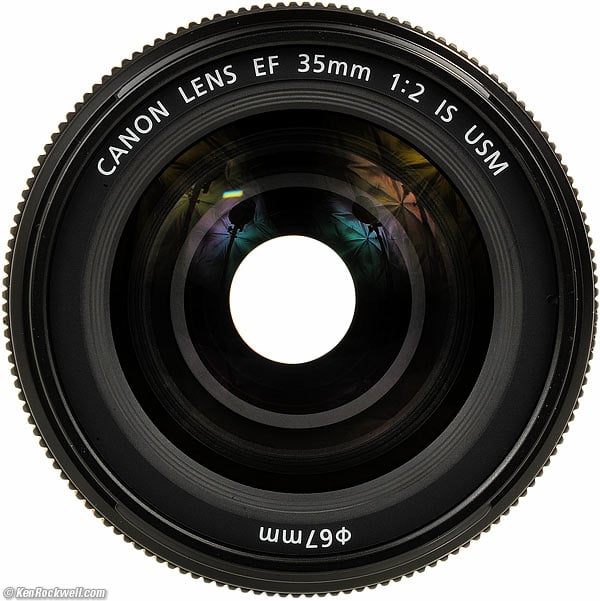
Canon 35mm f/2 IS at f/2, EF diaphragm not visible.
8 blades.
Stops down to f/22.
Rounded to about f/4, octagonal from f/5.6~22.
Hard Infinity Focus Stop? top
No.
You have to let the AF system focus for you at infinity.
Focus Scale top
Yes, abbreviated, and with a big mistake in the footage scale!
Some summer intern was tasked with creating the green footage scale who ignorantly converted the 0.7 and 2 meter markings to feet, marking the scale at 2.3 feet and 6.5 feet.
The footage scale should be marked in round numbers, like 2, 5 and 10 feet, instead!
Depth-of-Field Scale top
Yes
Infra-Red Focus Index top
Yes, red dot.
Most likely for 800 nm.
Filter Thread top
67mm.
Plastic.
Does not move.
Size top
Canon specifies 3.1" (77.9mm) diameter by 2.5" (62.6mm) long.
Weight top
11.855 oz. (336.1g), measured.
Canon specifies 11.8 oz. (335g).
Caps top
New 67mm E-67II front, included. It's a copy of Nikon's newest caps and much improved from Canon's previous caps.
Standard EOS cap rear, included.
Hood top
Optional EW-72 plastic bayonet, $50 extra. I wouldn't buy it; I don't use hoods.
Included top
Lens and caps; that's it.
Introduced top
06 November 2012.
Promised top
Promised for December 2012.
Shipping since top
December 2012.
Quality top
Made in Japan.
Price, USA top
2013 November ~ 2017 January: $550.
2012 November - 2013 January: $850.
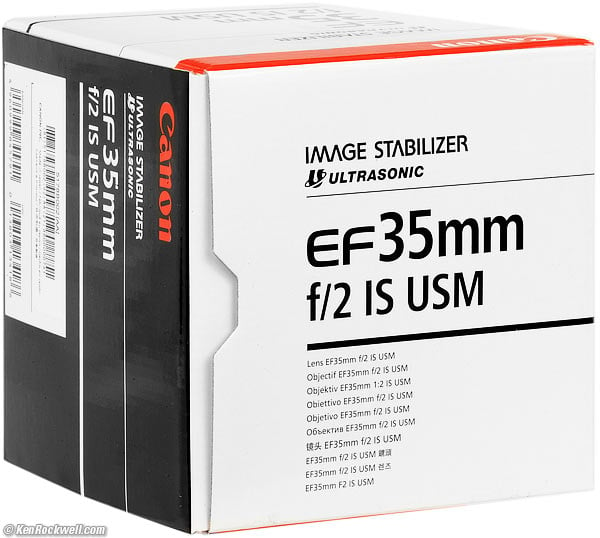
Box, Canon 35mm f/2 IS.
Performance top
Intro Specs Performance Compared Recommendations
Overall Autofocus Bokeh Breathing Color Coma
Distortion Ergonomics Falloff Filters Flare & Ghosts
Image Stabilization Lateral Color Fringes Macro Mechanics
Sharpness Spherochromatism Sunstars
Overall performance top
The Canon 35mm f/2 IS is optically superb and handles very well.
Its only vices are that it costs three times what the optically very similar previous EF 35mm f/2 costs, and isn't built any tougher. For not much more than the price of this 35/2 IS today in January 2013, you get the fully professional Canon 35mm f/1.4 L instead.
Autofocus performance top
Autofocus is fast and nearly silent, as we take for granted with Canon. For the still subjects I shoot, it's almost instantaneous.
Auto/Manual Switching
Just grab the focus ring at any time for instant manual-focus override.
Only move the AF-MF switch if you want to disable the camera from auto focusing.
AF Speed
AF is fast!, as Canons always are.
The AF motor might be silent, but you will hear some internal sliding and rattling as it focuses.
AF Accuracy and Consistency
I saw no autofocus error on my Canon 5D Mk III.
Especially at f/2, every shot is dead-nuts on.
Yes! Perfection!
Manual Focus
Manual focus is easy; just grab the ring.
Bokeh performance top
Bokeh, the quality of out-of-focus areas as opposed to the degree of defocus, is neutral to poor.
It's nice and neutral at close distances at f/2 where you need it most, but becomes quite nasty when focused at about 3 meters (10 feet) or more with backgrounds at infinity at f/2.
For superb bokeh, use the EF 35mm f/1.4 L, which even at the same f/2 aperture, has much better bokeh, and opens to f/1.4.
Here are crops from the center of full-frame 22MP 5D Mk III images at 25%. In other words, each crop shows about one-fifth of the image horizontally, and about one-third vertically. If each is about 3" (7.5 cm) on your screen, the complete images would print at about 10 x 15" (25 x 38 cm) at this same magnification. The focus is on a reference phase lattice at about a foot or two (0.5m) with synthetic reference vegetation at 15 meters (50 feet):
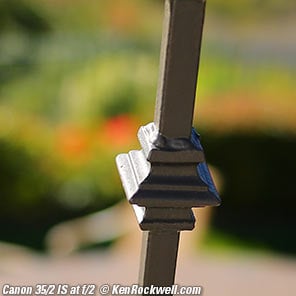 |
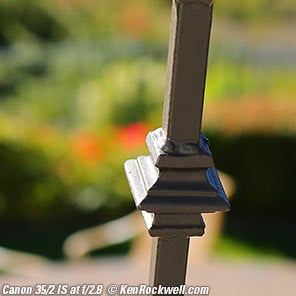 |
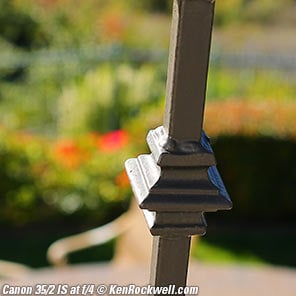 |
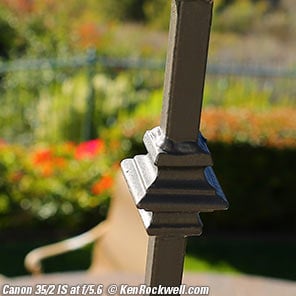 |
These look pretty good, since I'm only 1 half-meter (1.5 feet) away.
Here's the bad news. This is a crop at 100% from the center of a full-frame 22MP 5D Mk III image of the background at f/2 at infinity, when focused at 3 meters (10 feet):
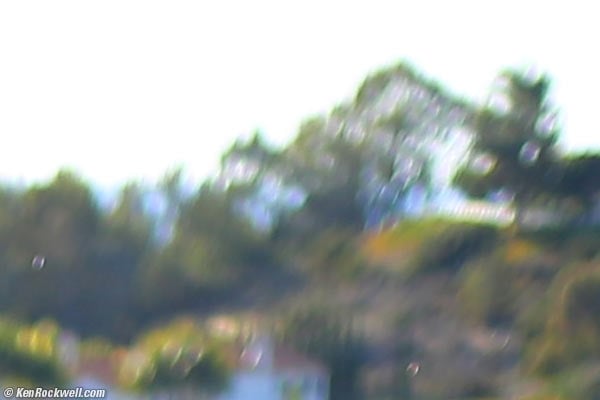
Crop from 22MP full-frame image at 100% at f/2, focus at 3 meters.
Focus Breathing performance top
Focus breathing (the image changing size as focused) is mostly of interest to cinematographers who don't want the image changing size ("breathing") as the lens is focused among different subjects.
The image from the Canon 35mm f/2 IS gets larger as focused more closely.
Color Rendition performance top
The color balance of this 35mm f/2 IS seems the same as my other Canon EF lenses.
Coma performance top
Coma, or saggital coma flare, is when points of light in the corners turn into batwing-shaped blobs. This is often a problem with fast normal or wide lenses.
To my surprise, this aspheric Canon 35 IS does have some coma at f/2. It gets better at f/2.8, and is gone completely by f/4.
This is only about as good as the previous 35mm f/2 and 35mm f/1.4 L at the same apertures.
Distortion performance top
The Canon 35mm f/2 IS has low to moderate barrel distortion, just a tad more than the previous 35mm f/2 or 35mm f/1.4 L.
Use these values in Photoshop's Lens Distortion tool to remove the distortion for more critical use, however a tiny bit of waviness remains:
| Factor on Full-Frame or 35mm | 35/2 IS |
||
Infinity |
+1.4 |
+1.3 |
+1.3 |
3m (10') |
+1.2 |
+1.0 |
+1.1 |
© 2013 KenRockwell.com. All rights reserved.
Ergonomics performance top
Canon 35mm f/2 IS. enlarge.
Ergonomics are just about perfect.
Just grab the big focus ring at any time for instant manual override. One firm fingertip will do it.
The AF - MF switch falls right under your thumb.
Falloff (darkened corners) performance top
Falloff is visible on film or without a profile at f/2, mostly gone at f/2.8, and completely gone by f/4.
It's so low that I didn't bother loading a lens profile into my Canon 5D Mark III, 6D or 1D X .
or other camera that uses lens profiles for correction, falloff is never visible at any setting.
I've greatly exaggerated this by shooting a flat gray target and presenting it against a gray background.
Canon 35mm f/2 IS falloff on full-frame 5D Mk III peripheral illumination control disabled (same results on film):
© 2012 KenRockwell.com. All rights reserved.
|
Filters, Use with performance top
The plastic 67mm filter threads are big enough that even two thick stacked filters won't cause any vignetting on full-frame (or any other format).
Go ahead, use any big, fat thick filter, and you'll still be able to add a second one, too!
Flare and Ghosts performance top
At f/8, direct view of mid-day tropical sun. bigger.
Flare and ghosts are very well controlled. You'll never see any flare or ghosts unless you put the full disc of the sun in your image and deliberately put something dark elsewhere to show anything, as I did here.
If you push it like this, you can get a dim green dagger opposite the light source, otherwise, no problem.
Image Stabilization performance top
By "sharp shots" I mean perfect tripod-equivalent sharpness when viewed at 100%, as shot on a 5D Mk III hand-held by me. For most uses, one can use much slower speeds. See Why IS Matters for more.
% Sharp Shots |
2 sec. |
1 |
1/2 |
1/4 |
1/8 |
1/15 |
1/30 |
IS Off |
0 |
10 |
30 |
50 |
85 |
||
IS ON |
5 |
0 |
16 |
100 |
100 |
100 |
100 |
For me, if we set the bar at the speed at which 50% of my shots are exactly as sharp as on a tripod, my slowest speed with IS Off is 1/15, and 1/3 with IS ON. That's a 2.5 stop improvement. Of course for most uses we can accept a little blur, and the percentages would be higher for all speeds — but the relative improvement provided by IS would stay the same.
Lateral Color Fringes performance top
Better than most Canon lenses, there are absolutely no visible lateral color fringes at 22MP full-frame, even if shot without a lens profile. This is a tiny bit better than the 35mm f/1.4 L, if you're shooting without a profile as we always do on 35mm film.
Macro performance top
At close-focus distance on full-frame, Canon 35 f/2 IS.
The images would be even tighter on smaller-format cameras (see crop factor).
It's super-sharp; here's a crop from a 22MP full-frame image at 100%:
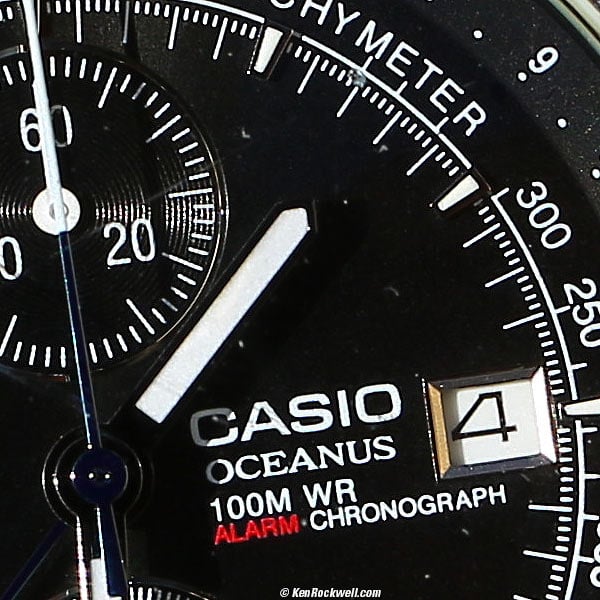
Crop from above image at 100%, shot at f/8 at ISO 100 on a Canon 5D Mk III. If this is 6" (15cm) wide on your screen, the full image would print at 39 x 58" (1 x 1.5 meters)!
Mechanics performance top
Rear, Canon 35mm f/2 IS. enlarge.
The Canon 35mm f/2 IS is made to typical consumer standards: all plastic, except for the glass and the mount. This is same as the 35mm f/2 (1990-) and nowhere near as good as the fully professional 35mm f/1.4 L (1998-).
Filter Threads
Plastic.
Hood Mount
Plastic.
Identity Ring
Plastic.
Focus Ring
Rubber-covered.
Barrel
Plastic.
Internals
I see mostly plastic with some metal.
Moisture seal at mount
No.
Mount
Chromed metal.
Markings
Paint.
Serial Number
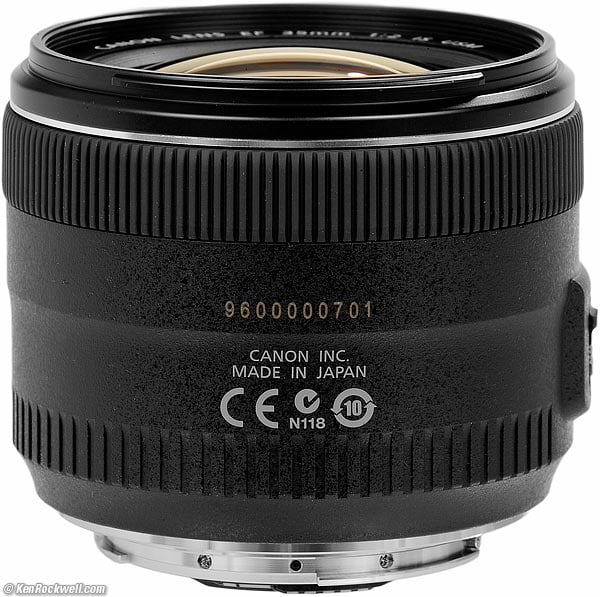
Bottom, Canon 35mm f/2 IS.
Laser-engraved into the bottom of the black plastic lens barrel.
Date Code
None found.
Noises When Shaken
Slight clunking.
Made in
Japan.
Sharpness performance top
Image sharpness depends more on you than your lens, and lens sharpness doesn't mean much to good photographers. It's the least skilled hobbyists who waste the most time blaming fuzzy pictures on their lenses, while real shooters know that few photos ever use all the sharpness of which their lenses are capable due to subject motion and the fact that real subjects are rarely perfectly flat, like this chair seat:
Fabric, close-up at f/8 at ISO 100, Canon 5D Mk III. Full-resolution © 22MP image.
Not bad for an unflat piece of fabric!This said, the Canon 35mm f/2 IS is among the sharpest wide lenses I've tested, just like the 35mm f/1.4 L (1998-) and original 35mm f/2 (1990-). The only differences between these and the 24-70/2.8 L II is if you're looking in the far corners on full-frame wide-open, in which case, the original 35/2 is slightly less sharp, and all the rest are also about the same, with this 35/2 IS and the 24-70/2.8 L II being very slightly better in the corners wide-open.
This 35/2 IS is extraordinarily sharp and contrasty, even at f/2. Throughout most of the image, there is little or no difference between f/2 and stopped down, as seen on a 22MP 5D Mark III at the test range at infinity. By f/2.8, 99% of the image has already reached optimum, and at f/4, the entire image is optimum.
The last couple of millimeters in the corners are a little softer at f/2 due to coma, improving greatly at f/2.8, where the corners are now 95% as sharp as the center. By f/4, the entire image is as sharp as the center — very sharp.
So long as you're in focus, sharpness doesn't vary much from perfection, except by f/11, where diffraction softens the image.
Throughout most of the image (except the last millimeter in the corners), this lens is just as sharp at f/2 as it is stopped down!
Hey, sorry to spare you endless boring charts, but with a lens this good, there's nothing to show other than sharp pictures under all conditions.
The biggest detriment to sharpness will be a lack of proper vision and technique, never this lens. I bought mine directly from Adorama. I can't vouch for anything if you buy from a local store or chain where you never really know who's opened and played with your lens before you buy it. I never buy retail; too many risks, so why pay more?

Canon's MTF curve, 35/2 IS.
Spherochromatism performance top
Spherochromatism, misnamed "color bokeh" by laymen, is when out-of-focus highlights take on color fringes at full aperture. This is common in fast lenses.
The Canon 35/2 IS has a very small amount of spherochromatism at f/2:
Full-frame image at f/2.
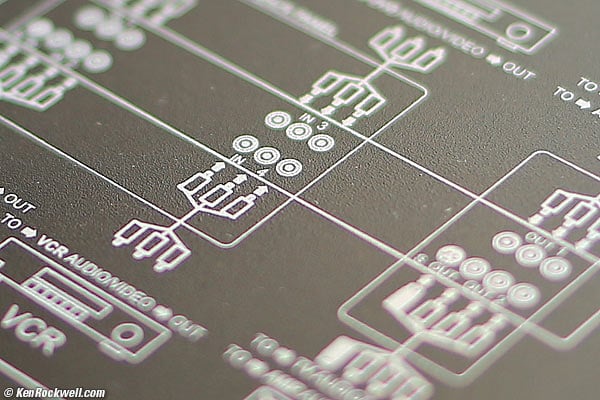
Crop from center of above image.
Background highlights may have slight green fringes, and foreground highlights may have slight magenta fringes at f/2.
This is normal, and helps bokeh, smoothing out foliage (green) backgrounds even further.
If you're in perfect focus, there are no fringes.
Spherochromatism is a completely different aberration from lateral color fringes.
Sunstars performance top
At f/8, direct view of mid-day tropical sun. bigger.
With its octagonal diaphragm, this Canon 35mm f/2 IS makes 8-pointed sunstars on brilliant points of light.
Why Canon re-used its old 8-blade diaphragm on this new lens is beyond me; I hate 8-pointed sunstars and prefer the magnificent 18-pointed sunstars of the 24-70/2.8 L II, or 10-pointed stars of the first 35/2.
Compared top
Intro Specs Performance Compared Recommendations
I've been making comparisons throughout this entire review.
This 35/2 IS is nice, but too expensive for what it is. The other 35mm Canon lenses all have very similar optics. The only reason to open your wallet for this IS lens versus the previous 35/2 lens is to get Image Stabilization (IS) and instant manual-focus override.
The much smaller and less expensive original 35/2 lens has optics which are just as good, but you have to move a switch to get to manual focus.
IS is only helpful for shooting hand-held at low ISOs in low light, and only for still subjects. With digital's' great high ISOs, I see no reason to need IS in a wide lens. IS is extremely useful in tele lenses, and doesn't do much with wide lenses since hand tremor is much less of a problem.
See also Compared to other Canon 35mm lenses.
Canon 24-70/2.8 L II, 35mm f/1.4 L, 35mm f/2 IS and 35mm f/2. enlarge.
Canon 35mm f/1.4 L, 35mm f/2 IS and 35mm f/2. enlarge.
Canon 35mm f/1.4 L and 35mm f/2 IS. enlarge.
Canon 35mm f/2 IS and 35mm f/2. enlarge.
Recommendations top
Intro Specs Performance Compared Recommendations
If you would you pay twice as much as the perfectly good previous-model Canon 35mm f/2 just to get instant manual-focus override and Image Stabilization (IS), this lens is for you.
Personally I'd get the smaller and far less expensive previous-model 35mm f/2 for half the price with only 63% of the weight and the same optical quality. Both are made mostly of plastic, but you have to move a switch for manual focus override on the older 35/2.
Personally I own the fully professional 35/1.4 L is much, much better made, and much better in low light for action, where IS can't help you. You can't see it here, but this new IS lens isn't made any better than the old 35/2, while the 35/1.4 is made much, much better to fully professional toughness. The 35/1.4 L has been a professional standard for decades so its price has fallen, making it a huge bargain at about $1,350.
For the 35/2 IS, I'd use a 67mm B+W 010 MRC UV filter for protection, or the Canon 67mm UV, or a 67mm Hoya HMC UV. These filters are all very good; the reason to pay more for the B+W is simply if you feel better with a $55 rather than a $33 filter on a $550 lens.
If you've found the effort I've spent in sharing this professional review helpful, this free website's biggest source of support is when you use these links, especially this link directly to it at Adorama and to it at Amazon, when you get anything, regardless of the country in which you live.
Thanks!
Ken.
© Ken Rockwell. All rights reserved. Tous droits réservés. Alle Rechte vorbehalten.
Help me help you top
I support my growing family through this website, as crazy as it might seem.
The biggest help is when you use any of these links when you get anything, regardless of the country in which you live. It costs you nothing, and is this site's, and thus my family's, biggest source of support. These places have the best prices and service, which is why I've used them since before this website existed. I recommend them all personally.
If you find this page as helpful as a book you might have had to buy or a workshop you may have had to take, feel free to help me continue helping everyone.
If you've gotten your gear through one of my links or helped otherwise, you're family. It's great people like you who allow me to keep adding to this site full-time. Thanks!
If you haven't helped yet, please do, and consider helping me with a gift of $5.00.
As this page is copyrighted and formally registered, it is unlawful to make copies, especially in the form of printouts for personal use. If you wish to make a printout for personal use, you are granted one-time permission only if you PayPal me $5.00 per printout or part thereof. Thank you!
Thanks for reading!
Mr. & Mrs. Ken Rockwell, Ryan and Katie.
Home Donate New Search Gallery Reviews How-To Books Links Workshops About Contact

